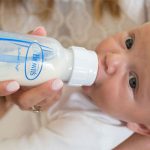 The act of giving a baby milk from a bottle, as opposed to breast feeding.
The act of giving a baby milk from a bottle, as opposed to breast feeding.
Supplying an infant with nutrients in a modified milk or milk like fluid called formula, fed through a bottle with a nipple similar to that of a breast. Public health experts recommend breastfeeding where possible, because the mother’s milk provides more completely balanced nutrition and temporary immunization against various kinds of diseases. But many women find breastfeeding too inconvenient, unattractive, or difficult to arrange, especially in a world where both parents often work, and not all women who choose to breastfeed can do so. Bottle feeding, though a second choice for doctors, is then a perfectly good alternative to breastfeeding. Mothers (and also fathers) are equally able to establish the close bonding relationship with the baby if they cuddle, rock, and talk with the child while bottle feeding.
Feeding of milk or formula to babies usually through sterilized bottles. Most formula is derived from cow’s milk that has been fortified with vitamin D and other vitamins, in an effort to make it as much like human milk as possible. Specially prepared formulas are available for infants with milk allergy or specific digestive disorders.
Infant nourishment involves the use of a milk product typically derived from altered cow’s milk. This formulaic milk comprises comparable ratios of protein, fat, lactose (the sugar found in milk), and minerals as those found in human milk. However, it lacks the beneficial antibodies present in breast milk. To compensate, vitamins are supplemented to ensure adequate nutrition.
In certain situations, when either the mother or child faces medical complications that hinder or discourage breastfeeding, bottle-feeding is advised as an alternative. Nevertheless, infants who are bottle-fed face an increased susceptibility to gastrointestinal infections compared to those who are breastfed. Additionally, they may be more prone to developing allergic disorders.
